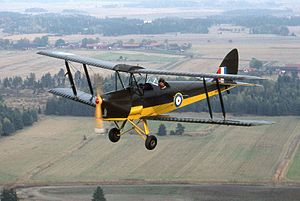| DH.82 Tiger Moth | |
|---|---|
 A Tiger Moth in 1989 | |
| General information | |
| Type | Trainer |
| Manufacturer | de Havilland Aircraft Company de Havilland Canada |
| Designer | |
| Status | In service for civil use |
| Primary users | Royal Air Force |
| Number built | 8,868[1] |
| History | |
| Manufactured | 1931–1944 |
| Introduction date | February 1932[2] |
| First flight | 26 October 1931 |
| Retired | 1959 |
| Developed from | de Havilland DH.60 Moth |
| Variants | Thruxton Jackaroo |
The de Havilland DH.82 Tiger Moth is a 1930s British biplane designed by Geoffrey de Havilland and built by the de Havilland Aircraft Company. It was operated by the Royal Air Force (RAF) and other operators as a primary trainer aircraft. In addition to the type's principal use for ab initio training, the Second World War had RAF Tiger Moths operating in other capacities, including maritime surveillance and defensive anti-invasion preparations; some aircraft were even outfitted to function as armed light bombers.
The Tiger Moth remained in service with the RAF until it was replaced by the de Havilland Chipmunk during the early 1950s. Many of the military surplus aircraft subsequently entered into civilian operation. Many nations have used the Tiger Moth in both military and civilian applications, and it remains in widespread use as a recreational aircraft. It is still occasionally used as a primary training aircraft, particularly for those pilots wanting to gain experience before moving on to other tailwheel aircraft. Many Tiger Moths are now employed by companies offering trial lesson experiences. The de Havilland Moth club, founded in 1975, is now an owners' association offering a mutual club and technical support.
- ^ "De Havilland Tiger Moth (D.H.82)", British aircraft, 1 July 2006, archived from the original on 27 September 2007, retrieved 12 August 2010
- ^ Bonné, Frans. "The De Havilland Tiger Moth". WW2 Warbirds. Archived from the original on 4 March 2016. Retrieved 5 May 2018.